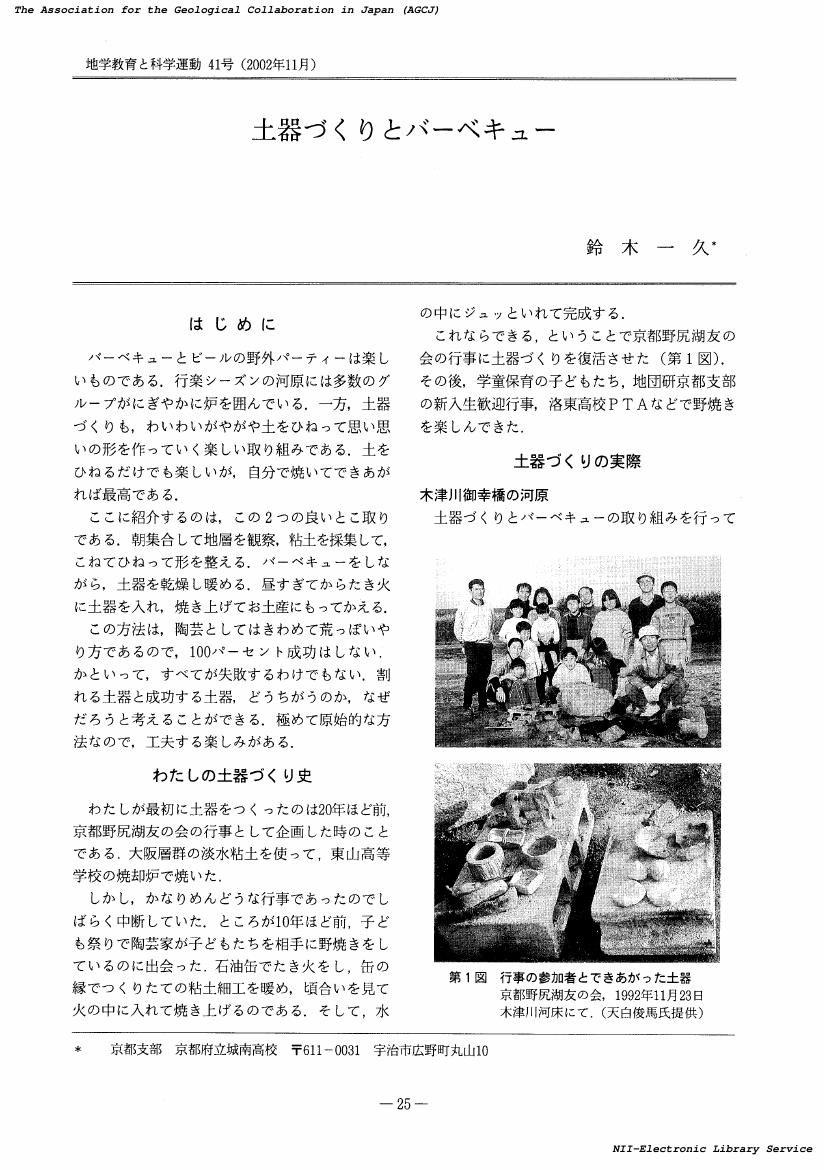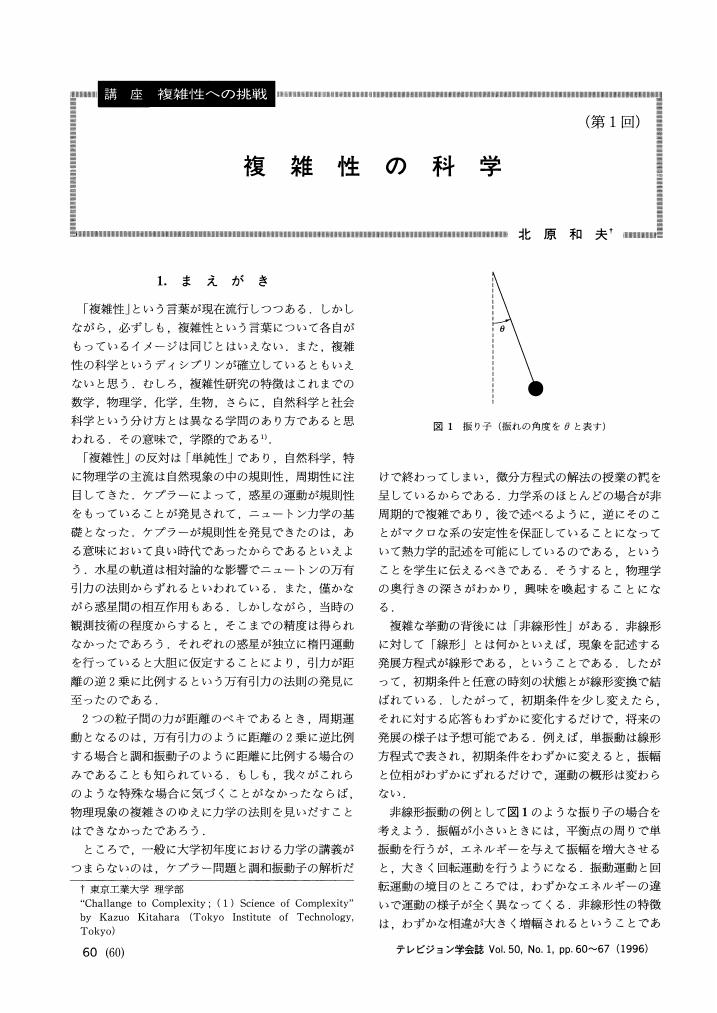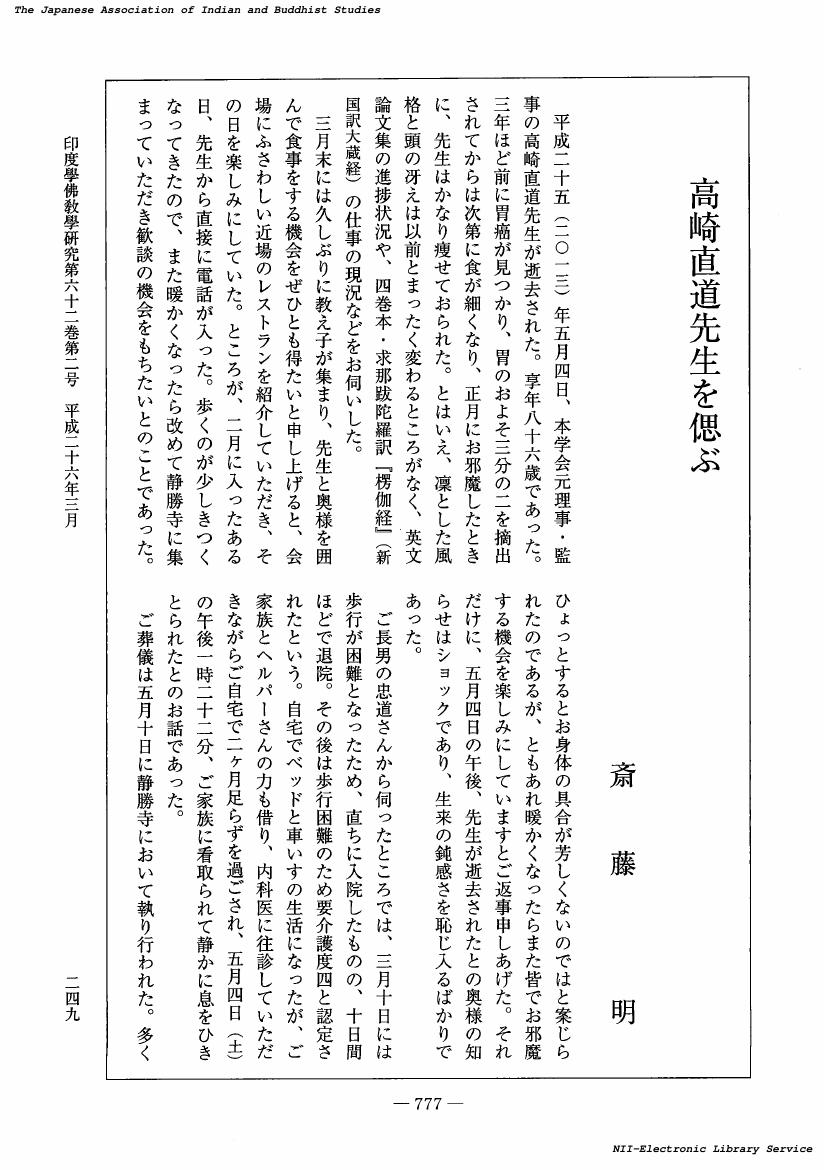2 0 0 0 2022年大学設置基準の批判的検討 教員配置基準を中心に
- 著者
- 中嶋 哲彦
- 出版者
- 日本科学者会議
- 雑誌
- 日本の科学者 (ISSN:00290335)
- 巻号頁・発行日
- vol.58, no.10, pp.44-50, 2023-10-01 (Released:2023-10-05)
2 0 0 0 OA 福岡県の「平成の大合併」を振り返る
- 著者
- 土肥 勲嗣
- 出版者
- 一般財団法人 福岡県地方自治センター
- 雑誌
- 地方自治ふくおか (ISSN:02872463)
- 巻号頁・発行日
- vol.64, pp.59-69, 2018 (Released:2019-03-31)
2 0 0 0 OA 土器づくりとバーベキュー
- 著者
- 鈴木 一久
- 出版者
- 地学団体研究会
- 雑誌
- 地学教育と科学運動 (ISSN:03893766)
- 巻号頁・発行日
- vol.41, pp.25-28, 2002-11-05 (Released:2018-03-29)
- 参考文献数
- 8
2 0 0 0 OA 博物館活動に於ける土器作り教室の一事例
- 著者
- 吉川 金利
- 出版者
- 飯田市美術博物館
- 雑誌
- 飯田市美術博物館 研究紀要 (ISSN:13412086)
- 巻号頁・発行日
- vol.17, pp.73-84, 2007 (Released:2017-10-01)
2 0 0 0 OA 複雑性への挑戦 (第1回) 複雑性の科学
- 著者
- 北原 和夫
- 出版者
- 一般社団法人 映像情報メディア学会
- 雑誌
- テレビジョン学会誌 (ISSN:03866831)
- 巻号頁・発行日
- vol.50, no.1, pp.60-67, 1996-01-20 (Released:2011-03-14)
- 参考文献数
- 21
2 0 0 0 OA U・ベックの「無知」の社会学 「戦略的無知」論に向けての展開可能性
- 著者
- 小松 丈晃
- 出版者
- 東北社会学研究会
- 雑誌
- 社会学研究 (ISSN:05597099)
- 巻号頁・発行日
- vol.98, pp.91-114, 2016-05-30 (Released:2021-12-29)
- 参考文献数
- 34
何か否定的な含みを感じさせる「無知」は、これまで長らく研究テーマの中心に据えられてこなかったが、近年社会学でも、「環境」や「科学・技術」などを主題する論考の中に、(リスクや不確実性に加えて)「無知」や「ネガティブな知識」といった概念を軸にするものが増加してきている。本稿では、ベックのリスク社会論が、もともとこの「無知(Nichtwissen, non-knowledge)」を中心的な鍵概念にしていたところに着目し、このような近年の「無知の社会学」の展開に対するベックの貢献を確認し、「戦略的無知」論を展開していくための視点を模索する。まず無知の社会学の近年の広がりを確認したあと(一)、無知概念が多様な内実を有している点を指摘する(二)。ついで、同じ再帰的近代化論とはいっても、ベックとギデンズがいかに異なるかを検討し(三)、ベックによる無知論に立ち入って、「知ることができない」と「知るつもりがない」の対立を軸にした考察から、無知の三つの次元への整理にいたる議論の展開過程を追尾する(四)。最後に、ベック以後の無知論の展開可能性の一つとして、「戦略的無知」という観点のもつ意味について述べる(五)。
2 0 0 0 OA 『日本昆虫目録 第8巻 双翅目』の出版と日本産双翅目相の解明度について
- 著者
- 中村 剛之
- 出版者
- 一般社団法人 日本昆虫学会
- 雑誌
- 昆蟲.ニューシリーズ (ISSN:13438794)
- 巻号頁・発行日
- vol.19, no.1, pp.22-30, 2016-01-05 (Released:2019-04-25)
- 参考文献数
- 8
- 著者
- 岡田 洋平 大久保 優 高取 克彦 梛野 浩司 徳久 謙太郎 生野 公貴 庄本 康治
- 出版者
- 理学療法科学学会
- 雑誌
- 理学療法科学 (ISSN:13411667)
- 巻号頁・発行日
- vol.24, no.1, pp.49-52, 2009 (Released:2009-04-01)
- 参考文献数
- 14
- 被引用文献数
- 1 1
〔目的〕本研究の目的は,Hoehn & Yahr(H&Y)3度以上のパーキンソン病患者において,pull testと過去1年間の転倒の有無との関係について検討することとした。〔対象〕本研究の対象は,H&Y 3度以上のパーキンソン病患者24名であった。〔方法〕評価項目はpull testと転倒歴とした。pull testと転倒との関連性について分析し,また,ROC曲線から転倒者を識別する上で最適なカットオフ値を設定した。〔結果〕転倒群は非転倒群と比較して、pull testのスコアは有意に高かった。pull testのスコアの1をカットオフ値にした際,転倒の有無を最も良好に識別可能であった(感度:94.7%,特異:60.0%)。〔結語〕pull testは,そのスコアの1をカットオフ値にすることにより,H&Y 3度以上のパーキンソン病患者の中から転倒の危険性が特に高いものを識別する上で有用な指標の1つとなる可能性が示唆された。
2 0 0 0 OA 明治・大正期の演歌における洋楽受容
- 著者
- 権藤 敦子
- 出版者
- The Society for Research in Asiatic Music (Toyo Ongaku Gakkai, TOG)
- 雑誌
- 東洋音楽研究 (ISSN:00393851)
- 巻号頁・発行日
- vol.1989, no.53, pp.1-27,L4, 1988-12-31 (Released:2010-02-25)
This article examines the way in which the music imported from the West during the Meiji (1868-1912) and Taisho (1912-1926) periods, as well as music that was formed in Japan under its influence, was incorporated into the enka of those periods. By viewing the change in this music during this long period of almost fifty years, it also seeks to clarify one aspect of the reception of Western music by the general populace of Japan.The introduction of Western music, which began around the end of the Tokugawa and beginning of the Meiji periods, has since exerted a substantial influence on the musical culture of Japan. However, although considerable research has been undertaken with regard to the reception of Western music by official bodies such as the Ongaku Torishirabegakari (‘Institute for musical investigation’, affiliated to the Ministry of Education), the question of how the general public received this music is one that has gained little attention. Among reasons for this are, firstly, that there are limits in terms of research material since data of relevance are unlikely to be found in official records, and secondly, that the term “general populace” includes a variety of peoples of differing cultural and social backgrounds, thus making it difficult to deal with the reception of music by the general populace as a single category.Accordingly, to bring about a detailed understanding of the various modes of reception of Western music, it is necessary to clarify each of them in turn by approaching it from a variety of angles. An attempt has been made in this article to survey one aspect of the reception of Western music by the general populace by means of examining changes in the music of the enka sung by enkashi (enka performers) during the Meiji and Taisho periods, which met with wide popularity at the time.In its present usage, the word “enka” refers in general terms to popular songs of the kayokyoku genre that are said to have “Japanese” musical and spiritual characteristics. Originally, however, enka were used along with kodan (narrative) and shibai (theatre) as a means of transmitting the message of the Meiji-period democratic movement to the general populace in a readily understandable form. Songs sung by the proponents of this movement were known as “soshi-bushi”. Later, they were taken over by street performers who sang the songs while selling copies of their texts. This article takes as its subject popular songs beginning with soshi-bushi and continuing through to the beginning of the Showa period (late 1920's to early 1930's), when recordings of these songs began to be made commercially.At first, enka played an extra-musical role in catching the attention of the populace to transmit to them the message of the democratic movement. For this reason it lacked any fixed musical form. It possessed, rather, a musical transcience and topicality, in that it freely set texts about any event that captured common attention to music that happened to be popular at the time, such as minshingaku (Chinese music of the Ming and Qing dynasties), shoka (songs in Western style used in education), Asakusa Opera and the like. Anticipating the preferences of the masses, enka reflected their contemporary attitudes towards music, and were widely appreciated by them.In this research, 280 songs verified from among those actually identified as enka have been listed according to the chronological order in which they were popular, and each song has been transcribed and analysed. As a result, it has become possible to divide the period from 1888 to 1932 into three sections. These are: a) the first period, 1888-1903, centring on a group of related pieces using traditional techniques, based on “Dainamaitobushi”
2 0 0 0 OA 華厳思想と即身成仏(智山教学大会特別講演)
- 著者
- 竹村 牧男
- 出版者
- 智山勧学会
- 雑誌
- 智山学報 (ISSN:02865661)
- 巻号頁・発行日
- vol.48, pp.1-25, 1999-03-31 (Released:2017-08-31)
2 0 0 0 OA 高崎直道先生を偲ぶ
- 著者
- 斎藤 明
- 出版者
- 日本印度学仏教学会
- 雑誌
- 印度學佛教學研究 (ISSN:00194344)
- 巻号頁・発行日
- vol.62, no.2, pp.777-782, 2014-03-20 (Released:2017-09-01)
- 著者
- 宮武 賴夫
- 出版者
- 橿原市昆虫館
- 雑誌
- 橿原市昆虫館研究報告 (ISSN:24370029)
- 巻号頁・発行日
- vol.2, pp.1-9, 2023 (Released:2023-10-07)
2 0 0 0 OA 柳田国男の学問における方法について
- 著者
- 中嶋 昌彌
- 出版者
- 社会学研究会
- 雑誌
- ソシオロジ (ISSN:05841380)
- 巻号頁・発行日
- vol.21, no.2, pp.74-84, 1976-06-30 (Released:2017-02-28)
2 0 0 0 OA 令和3 年度 飛鳥地域における昆虫相調査
- 著者
- 木村 史明 池田 大
- 出版者
- 橿原市昆虫館
- 雑誌
- 橿原市昆虫館研究報告 (ISSN:24370029)
- 巻号頁・発行日
- vol.2, pp.16-36, 2023 (Released:2023-10-07)
2 0 0 0 OA イデオロギー装置としての「英米語」 日本におけるその潜在的諸機能
- 著者
- ましこ ひでのり
- 出版者
- 関東社会学会
- 雑誌
- 年報社会学論集 (ISSN:09194363)
- 巻号頁・発行日
- vol.1995, no.8, pp.179-190, 1995-06-05 (Released:2010-04-21)
- 参考文献数
- 26
In Japan, there are some serious latent functions of American/British English. The more the English educational system grows in Japan, the fewer chances the Japanese have for studying other foreign languages (the “Matthew Effect”), the more dominant an Anglo-Saxon's ethos becomes. They also would rational ize the hierarchy of Japanese labor market that is organized by the various differeces in cultural capitals. English-loan words have become the outer skin of Japanese language body, and threaten to become its true skin. But English-loan words cannot be rigarded as genuine English words.
2 0 0 0 OA 日本産イットウダイ亜科 (キンメダイ目) 魚類の再検討およびイットウダイ属1新種の記載
- 著者
- 清水 長 山川 武
- 出版者
- The Ichthyological Society of Japan
- 雑誌
- 魚類学雑誌 (ISSN:00215090)
- 巻号頁・発行日
- vol.26, no.2, pp.109-147, 1979-09-15 (Released:2010-06-28)
- 参考文献数
- 115
今日までに目本から知られているすべての種, 西太平洋産の2種, さらに日本産の1新種を含むイットウダイ亜科2属18種の分類学的研究を行い, 各種のシノニムを詳細に論じた.この亜科には, イットウダイ属Adioryxとウケグチイットウダイ属Flammeoの2属が知られ, 両者は背鰭第11棘の位置で区別される。この棘は, イットウダイ属では第10棘と背鰭第1軟条との中間に位置し, ウケグチイットウダイ属では背鰭第1軟条に極めて近く位置する。イットウダイ属の分類には計数的形質のほかに, 鼻骨後部の棘, 鼻孔の棘および第1眼下骨上縁の棘もしくは鋸歯の有無が有効な形質である.本属の日本産10種, ハナエビスA.furcatus, トガリエビスA.spinifer, クラカケエビス (新称) A.caudinaculatus, スミツキカノコA.cornutus, イットウダイA.spinosissimus, アヤメェビスA.ruber, ホシエビスA.lacteoguttatus, アオスジエビスA.tiere, ニジエビスA.diadena, テリエビスA.itiodaiおよび1新種バラエビスA.dorsomaculatusの記載が与えられた.この新種は鼻孔の後縁 (時には前縁にも) に小棘をもつ, 第1眼下骨上縁に鋸歯をもっ, 鼻骨後部は平滑で棘をもたない, 側線鱗数32-35, 体色は全体に赤色で背鰭第1棘から第3棘の問の鰭膜の下方部に黒斑をもつなどの特徴により他のいずれの既知の種とも区別される.日本以外からのスミレエビス (新称) A.violaceus, ヒメエビスA.microstomus, サクラエビス (新称) A.tiereoidesの3種を含めて, 西太平洋産イットウダイ属14種の実用的検索が作製された.ウケグチイットウダイ属4種は, 背鰭第11棘の長さ, 側線上方鱗数, 胸・臀鰭条数および背鰭棘部鰭膜上の黒色斑紋の有無と形により容易に識別される.これら4種の記載と検索が与えられた.
- 著者
- 東 昭 安田 邦男
- 出版者
- 一般社団法人 日本機械学会
- 雑誌
- 日本機械学会誌 (ISSN:24242675)
- 巻号頁・発行日
- vol.92, no.851, pp.890-897, 1989-10-05 (Released:2017-06-21)
- 著者
- Keiko Fukino Daisuke Ueshima Tetsuo Yamaguchi Atsushi Mizuno Kazuki Tobita Kenji Suzuki Naotaka Murata Kentaro Jujo Takahide Kodama Fumitaka Nakamura Michiaki Higashitani
- 出版者
- The Japanese Circulation Society
- 雑誌
- Circulation Journal (ISSN:13469843)
- 巻号頁・発行日
- pp.CJ-23-0215, (Released:2023-10-06)
- 参考文献数
- 48
Background: The mechanism underlying a poor prognosis in patients with lower-extremity artery disease (LEAD) with heart failure is unknown. We examined the prognostic impact of the left ventricular ejection fraction (LVEF) in patients with LEAD who underwent endovascular therapy (EVT).Methods and Results: From August 2014 to August 2016, 2,180 patients with LEAD (mean age, 73.2 years; male, 71.9%) underwent EVT and were stratified into low-LVEF (LVEF <40%; n=234, 10.7%) and not-low LVEF groups. In the low- vs. not-low LVEF groups, there was a higher prevalence of heart failure (i.e., history of heart failure hospitalization or New York Heart Association functional class III or IV symptoms) (44.0% vs. 8.3%, respectively), diabetes mellitus, chronic kidney disease, below-the-knee lesion, critical limb ischemia, and incidence of major cardiovascular and cerebrovascular events (MACCEs) and major adverse limb events (MALEs) (P<0.001, all). Low LVEF independently predicted MACCEs (hazard ratio: 2.23, 95% confidence interval: 1.63–3.03; P<0.001) and MALEs (hazard ratio: 1.85, 95% confidence interval: 1.15–2.96; P=0.011), regardless of heart failure (P value for interaction: MACCEs: 0.27; MALEs: 0.52).Conclusions: Low LVEF, but not symptomatic heart failure, increased the incidence of MACCEs and MALEs. Intensive cardiac dysfunction management may improve LEAD prognosis after EVT.
2 0 0 0 OA 診療報酬の適正評価に向けた運動器理学療法の研究戦略
- 著者
- 田中 亮
- 出版者
- 一般社団法人日本理学療法学会連合
- 雑誌
- 理学療法学 (ISSN:02893770)
- 巻号頁・発行日
- vol.41, no.8, pp.573-578, 2014-12-20 (Released:2017-06-10)
2 0 0 0 OA PCBとヒト精子におけるエピジェネティクス
- 著者
- 有馬 隆博
- 出版者
- 日本毒性学会
- 雑誌
- 日本毒性学会学術年会 第44回日本毒性学会学術年会
- 巻号頁・発行日
- pp.S23-3, 2017 (Released:2018-03-29)
近年我が国の晩婚化、少子化の社会情勢と、医療技術の進歩により、既婚者の15−20%が不妊治療を受けている。また、そのおよそ40%は、男性不妊(精子異常)で、過去10年間で患者数は約25倍に増加していることが報告されている。一方、以前よりエストロゲン様作用を有する環境由来化学物質が、ヒトの性腺(生殖細胞)に影響を及ぼし、オスのメス化、精子数減少などに影響を与え、種の存続に関わる事が社会的話題となったが、その関連性については、十分な科学的根拠がないため、未だ明らかにされていない。環境由来化学物質は、エピジェネティックな修飾により、遺伝子発現に影響を及ぼすことが知られている。エピジェネティクスとは、DNAの塩基配列の変化を伴わない、遺伝子発現制御に関わる後付けの修飾である。主たる修飾として、DNAのメチル化、ヒストンのアセチル化やメチル化が知られている。このエピジェネティックな修飾は、生殖細胞形成過程では、『細胞の記憶』として遺伝子刷り込み機構(ゲノムインプリンティング)として知られている。インプリンティングとは、特定の親由来の遺伝子が選択的に発現する現象で、哺乳類の正常な発生、分化に必須な現象である。また、この機構の破綻は、先天性疾患に限らず、乳幼児の行動、性格異常、成人疾患にも影響を与える。本学会では、男性不妊症患者を対象に化学物質としてPCBに注目し、ヒト精子へどのような影響を与えているのか、精子の形態と機能の両面から解析を行い、その関連性について発表したい。









